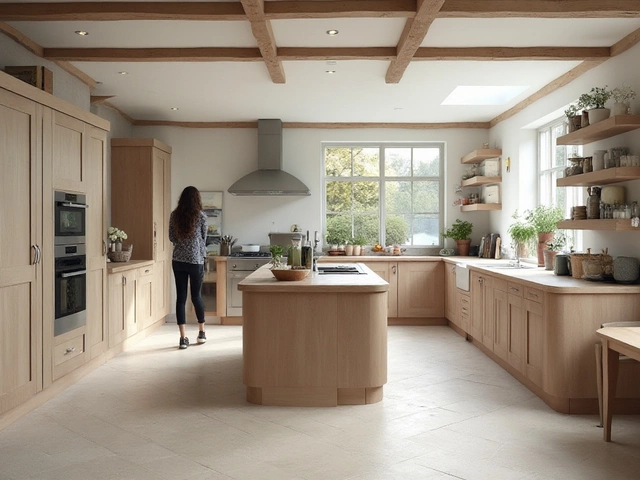First Step in Renovating a House: Laying the Foundation for Success

So, you're thinking about renovating your house, huh? Whether it's turning your dull kitchen into a modern masterpiece or just adding a little more life to the living room, the key to a successful renovation is starting off on the right foot. The first step might surprise you, but it's all about having a well-thought-out plan.
Think of this like building a house of cards – without a solid foundation, the next steps won't hold up, and you'll find yourself in a real pickle. Before you even think of picking up a hammer, start by dreaming big but planning smart. What's your end vision? Knowing this saves time and money and steers clear of headaches down the road.
- Dreaming and Planning
- Setting a Realistic Budget
- Hiring the Right Professionals
- Permits and Legalities
Dreaming and Planning
Alright, first things first. Grab a cup of coffee, sit back, and let your imagination run wild. This is the fun part of home renovation—dreaming about what your ideal space looks like! Whether it's a chic, modern kitchen or a cozy, rustic living room, everything starts here.
Now, dreaming is just one half of the equation. Planning is where the rubber meets the road. And, trust me, having a solid plan will save you from a ton of stress later. So, what should your planning process look like?
Visualizing Your Space
Use tools like Pinterest or mood boards to help you visualize the concepts. Sure, they might feel like they're more for arty types, but having a visual goal helps ensure everyone’s on the same page.
Setting Clear Goals
Be clear about what you want to achieve. Is it more space, better lighting, or increased home value? Identify your primary goals to prevent getting sidetracked by less essential ideas. Focus on the top priorities before diving into the nitty-gritty details.
Determining the Scope of Your Project
This is where many people trip up. It’s easy to go overboard, so decide early on how intense your renovation planning will be. Are you gutting the entire house or just sprucing up one room? Knowing this helps in organizing the upcoming tasks logically.
DIY or Professional Help?
This decision can make or break your project. Sometimes it pays to hire pros to handle complex tasks. On the other hand, if you’re handy or looking to save some bucks, YouTube is packed with tutorials for simpler tasks.
In short, having a comprehensive plan will not only guide you but also keep you grounded and focused. So, take those dreams and turn them into actionable steps. Up next: setting a realistic budget—stay tuned!
Setting a Realistic Budget
Alright, so you’ve got big dreams for your home renovation, but let's pump the brakes and talk about the bucks you’ll need. Having a clear understanding of your finances is clutch for any home renovation success. You really don't want to run out of money halfway through turning that spare bedroom into a chic home office.
Start with a Detailed Estimate
First things first—get some estimates. Reach out to a couple of contractors to get a ballpark idea of what your dream renovation might set you back. You might be thinking of doing it all DIY-style, but getting a pro's input can't hurt, and they might catch something you missed.
Break It Down
Once you have a rough number, break it down section by section. This is especially important if you’re renovating several rooms or areas. It’s like dividing a pizza; some slices (or rooms) are just going to need more toppings (or funds).
- Kitchen: Could be 25-30% of your budget.
- Bathrooms: Expect 20-30% each if more substantial work is needed.
- Living Room: Budget around 10-15% here.
Include the Unexpected
Here’s a juicy tip: always expect the unexpected. Your wallet will thank you later. Set aside about 10-20% of your total budget for those “oops!” moments. Trust me, they happen more often than you’d think.
Find Ways to Save
We all love a good bargain. Check for sales or discounts on materials, and don’t shy away from mixing high and low costs. Consider repurposing materials you already have. Vintage chic goes a long way!
Ultimately, the goal is to balance your ambitions with what your wallet can handle. Remember, it’s a marathon, not a sprint, and having a strong budget game plan sets you up for a winning renovation!

Hiring the Right Professionals
Let's be real for a second: knowing when to bring in the pros can make or break your home renovation. Sure, DIY can be tempting, but when it comes to making structural changes or dealing with complex systems, you're going to want someone who knows their stuff.
Start by identifying what kind of professional you need. For major structural changes, you'll likely need an architect or a structural engineer. For kitchens or plumbing, a qualified plumber or electrician is your go-to. Research is key here—it's not just about skills, but also about finding someone who gets your vibe and vision.
How to Choose the Right Pro
- Ask for Recommendations: Word of mouth is powerful. Friends, family, or even online reviews can provide honest insights on who to hire and who to avoid.
- Check Credentials: Make sure your pick has the right licenses and certifications. It shows they're legit and good to go for the job.
- Interview Several Options: Don’t just settle for the first quote. Meet a few pros and ask them specifics about your project, timelines, and costs. See who feels like the right fit.
- Clarify the Contract: A clear, detailed contract avoids misunderstandings. It should cover project scope, timeline, budget, and terms.
Professional fees can vary widely. On average, expect to spend around 10% of your house renovation budget on hiring professionals. It might sound like a chunk, but it's often worth it to avoid future hassles.
Remember, hiring the right help isn't just about skills, it's about building a good working relationship. Someone you communicate well with can make this journey not only doable but enjoyable. And isn't that what it's all about—turning your dreams into reality, one step at a time?
Permits and Legalities
Alright, let's talk about the nitty-gritty part of home renovation – the permits and legal stuff. It might sound like the least exciting aspect, but trust me, it's crucial for a smooth ride. Without the right permits, you could face fines or be forced to tear down your hard work. So, let’s get this nailed down.
Do You Need a Permit?
Whether or not you need a permit can depend on the scale of your project. For small cosmetic changes like painting or installing new cabinets, you're probably in the clear. But for bigger tasks – say, knocking down walls or adding new rooms – getting a permit is a must.
How to Get a Permit?
Start by contacting your local building department. They'll let you know exactly what you need. The process usually involves filling out a form, paying a fee, and possibly having plans drawn up by an architect or engineer. Don't worry if this sounds daunting; they’re there to help. Another tip? If you’re hiring the right professionals, they might handle this step for you.
Understanding Zoning Laws
Zoning laws are local regulations that dictate how properties can be used in certain areas. For instance, you might face restrictions on building heights or colors. Before diving into your project, double-check these laws with your local zoning office to avoid breaking any rules. Ignoring these can seriously derail your project.
Common Permits Required
- Building Permit
- Electrical Permit
- Plumbing Permit
- Mechanical Permit
Each has its own set of rules and needed inspections. Inspections are typically required at various stages of your project, so stay on top of those to make sure everything is up to code.
Having your construction plans reviewed and approved can take a few weeks. It's a small price to pay for dodging future complications, and while it might cost a bit, the peace of mind is priceless. Don't forget to display your permit prominently at your work site; it's part of the deal!


